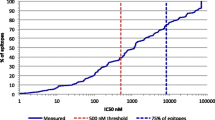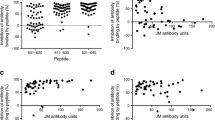Abstract
Purpose
In this study, we explored the breadth of CD8 T cell reactivity to preproinsulin (PPI) in type 1 diabetes.
Materials and Methods
We tested a complete peptide set in pools covering all 406 potential 8–11mer epitopes of PPI and 61 algorithm-predicted human leukocyte antigen (HLA)-A2-specific epitopes (15 pools) from islet-specific glucose-6-phophatase catalytic subunit-related protein (IGRP), using a CD8-specific granzyme B enzyme-linked immunosorbent spot assay.
Results
Responses were seen to 64 of the 102 PPI pools in two or more newly diagnosed patients (63%) compared to 11 pools in the control subjects (11%, p < 0.0001, Fisher’s exact test). We identified five pools containing 20 peptides, which distinguished patients from control subjects, most of which had predicted low-affinity binding to HLA class I molecules. In contrast, fewer (5 of 15 = 33%) IGRP peptide pools, selected by higher binding affinity for HLA-A2 (present in seven of eight patients and five of seven control subjects), stimulated responses in two or more patients, and none stimulated responses in more than two control subjects (p = 0.042, Fisher’s exact test).
Conclusion
Thus, we conclude that CD8 T cell reactivity to PPI in patients with type 1 diabetes can be much broader than shown previously and more diverse than seen in control subjects. Furthermore, responses were often stimulated by peptides with low predicted HLA-binding affinities.




Similar content being viewed by others
References
Atkinson MA, Eisenbarth GS. Type 1 diabetes: new perspectives on disease pathogenesis and treatment. Lancet 2001;358:221–9.
Serreze DV, Leiter EH. Genes and cellular requirements for autoimmune diabetes susceptibility in nonobese diabetic mice. Curr Dir Autoimmun 2001;4:31–67.
Lieberman SM, DiLorenzo TP. A comprehensive guide to antibody and T-cell responses in type 1 diabetes. Tissue Antigens 2003;62:359–77.
Rathmann S, Rajasalu T, Rosinger S, Schlosser M, Eiermann T, Boehm BO, et al. Preproinsulin-specific CD8+ T cells secrete IFN{gamma} in human type 1 diabetes. Ann NY Acad Sci 2004;1037:22–5.
Toma A, Haddouk S, Briand JP, Camoin L, Gahery H, Connan F, et al. Recognition of a subregion of human proinsulin by class I-restricted T cells in type 1 diabetic patients. Proc Natl Acad Sci USA 2005;102:10581–6.
Hassainya Y, Garcia-Pons F, Kratzer R, Lindo V, Greer F, Lemonnier FA, et al. Identification of naturally processed HLA-A2-restricted proinsulin epitopes by reverse immunology. Diabetes 2005;54:2053–9.
Mallone R, Martinuzzi E, Blancou P, Novelli G, Afonso G, Dolz M, et al. CD8+ T-cell responses identify {beta}-cell autoimmunity in human type 1 diabetes. Diabetes 2007;56:613–21.
Ou D, Jonsen LA, Metzger DL, Tingle AJ. CD4+ and CD8+ T-cell clones from congenital rubella syndrome patients with IDDM recognize overlapping GAD65 protein epitopes. Implications for HLA class I and II allelic linkage to disease susceptibility. Hum Immunol 1999;60:652–64.
Panina-Bordignon P, Lang R, van Endert PM, Benazzi E, Felix AM, Pastore RM, et al. Cytotoxic T cells specific for glutamic acid decarboxylase in autoimmune diabetes. J Exp Med 1995;181:1923–7.
Panagiotopoulos C, Qin H, Tan R, Verchere CB. Identification of a beta-cell-specific HLA class I restricted epitope in type 1 diabetes. Diabetes 2003;52:2647–51.
Standifer NE, Ouyang Q, Panagiotopoulos C, Verchere CB, Tan R, Greenbaum CJ, et al. Identification of Novel HLA-A*0201-restricted epitopes in recent-onset type 1 diabetic subjects and antibody-positive relatives. Diabetes 2006;55:3061–7.
Ouyang Q, Standifer NE, Qin H, Gottlieb P, Verchere CB, Nepom GT, et al. Recognition of HLA class I-restricted beta-cell epitopes in type 1 diabetes. Diabetes 2006;55:3068–74.
Wong FS, Karttunen J, Dumont C, Wen L, Visintin I, Pilip IM, et al. Identification of an MHC class I-restricted autoantigen in type 1 diabetes by screening an organ-specific cDNA library. Nat Med 1999;5:1026–31.
Kimura K, Kawamura T, Kadotani S, Inada H, Niihira S, Yamano T. Peptide-specific cytotoxicity of T lymphocytes against glutamic acid decarboxylase and insulin in type 1 diabetes mellitus. Diabetes Res Clin Pract 2001;51:173–9.
Martinez NR, Augstein P, Moustakas AK, Papadopoulos GK, Gregori S, Adorini L, et al. Disabling an integral CTL epitope allows suppression of autoimmune diabetes by intranasal proinsulin peptide. J Clin Invest 2003;111:1365–71.
Pinkse GG, Tysma OH, Bergen CA, Kester MG, Ossendorp F, van Veelen PA, et al. Autoreactive CD8 T cells associated with {beta} cell destruction in type 1 diabetes. Proc Natl Acad Sci USA 2005;102:18425–30.
Arden SD, Zahn T, Steegers S, Webb S, Bergman B, O’Brien RM, et al. Molecular cloning of a pancreatic islet-specific glucose-6-phosphatase catalytic subunit-related protein. Diabetes 1999;48:531–42.
Verdaguer J, Schmidt D, Amrani A, Anderson B, Averill N, Santamaria P. Spontaneous autoimmune diabetes in monoclonal T cell nonobese diabetic mice. J Exp Med 1997;186:1663–76.
Lieberman SM, Evans AM, Han B, Takaki T, Vinnitskaya Y, Caldwell JA, et al. Identification of the beta cell antigen targeted by a prevalent population of pathogenic CD8+ T cells in autoimmune diabetes. Proc Natl Acad Sci USA 2003;100:8384–8.
Wong CP, Li L, Frelinger JA, Tisch R. Early autoimmune destruction of islet grafts is associated with a restricted repertoire of IGRP-specific CD8+ T cells in diabetic nonobese diabetic mice. J Immunol 2006;176:1637–44.
Takaki T, Marron MP, Mathews CE, Guttmann ST, Bottino R, Trucco M, et al. HLA-A*0201-restricted T cells from humanized NOD mice recognize autoantigens of potential clinical relevance to type 1 diabetes. J Immunol 2006;176:3257–65.
Bingley PJ, Bonifacio E, Williams AJ, Genovese S, Bottazzo GF, Gale EA. Prediction of IDDM in the general population: strategies based on combinations of autoantibody markers. Diabetes 1997;46:1701–10.
Rammensee H, Bachmann J, Emmerich NP, Bachor OA, Stevanovic S. SYFPEITHI: database for MHC ligands and peptide motifs. Immunogenetics 1999;50:213–9.
Kaufman DL, Clare-Salzler M, Tian J, Forsthuber T, Ting GS, Robinson P, et al. Spontaneous loss of T-cell tolerance to glutamic acid decarboxylase in murine insulin-dependent diabetes. Nature 1993;366:69–72.
Tisch R, Yang XD, Singer SM, Liblau RS, Fugger L, McDevitt HO. Immune response to glutamic acid decarboxylase correlates with insulitis in non-obese diabetic mice. Nature 1993;366:72–5.
Ott PA, Dittrich MT, Herzog BA, Guerkov R, Gottlieb PA, Putnam AL, et al. T cells recognize multiple GAD65 and proinsulin epitopes in human type 1 diabetes, suggesting determinant spreading. J Clin Immunol 2004;24:327–39.
Moudgil KD, Sercarz EE. Understanding crypticity is the key to revealing the pathogenesis of autoimmunity. Trends Immunol 2005;26:355–9.
Wong FS, Moustakas AK, Wen L, Papadopoulos GK, Janeway CA Jr. Analysis of structure and function relationships of an autoantigenic peptide of insulin bound to H-2K(d) that stimulates CD8 T cells in insulin-dependent diabetes mellitus. Proc Natl Acad Sci USA 2002;99:5551–6.
Jarchum I, Baker JC, Yamada T, Takaki T, Marron MP, Serreze DV, et al. In vivo cytotoxicity of insulin-specific CD8+ T-cells in HLA-A*0201 transgenic NOD mice. Diabetes 2007;56:2551–60.
Olcott AP, Tian J, Walker V, Dang H, Middleton B, Adorini L, et al. Antigen-based therapies using ignored determinants of beta cell antigens can more effectively inhibit late-stage autoimmune disease in diabetes-prone mice. J Immunol 2005;175:1991–9.
Blancou P, Mallone R, Martinuzzi E, Severe S, Pogu S, Novelli G, et al. Immunization of HLA class I transgenic mice identifies autoantigenic epitopes eliciting dominant responses in type 1 diabetes patients. J Immunol 2007;178:7458–66.
Arif S, Tree TI, Astill TP, Tremble JM, Bishop AJ, Dayan CM, et al. Autoreactive T cell responses show proinflammatory polarization in diabetes but a regulatory phenotype in health. J Clin Invest 2004;113:451–63.
Acknowledgments
C.B. was supported by a Diabetes UK studentship. F.S.W. was a Wellcome Trust Senior Fellow in Clinical Science. We are very grateful to Mr. L. Keen at the National Blood Service for the HLA typing analysis and to Mr. A.J.K. Williams and Prof. P.J. Bingley for the autoantibody measurements. We would also like to thank Mr. S.J. Chapman for his technical assistance and the physicians and diabetes specialist nurses in all of the collaborating centers for referring newly diagnosed patients to SWENDIC.
Author information
Authors and Affiliations
Corresponding author
Rights and permissions
About this article
Cite this article
Baker, C., Petrich de Marquesini, L.G., Bishop, A.J. et al. Human CD8 Responses to a Complete Epitope Set from Preproinsulin: Implications for Approaches to Epitope Discovery. J Clin Immunol 28, 350–360 (2008). https://doi.org/10.1007/s10875-008-9177-4
Received:
Accepted:
Published:
Issue Date:
DOI: https://doi.org/10.1007/s10875-008-9177-4




